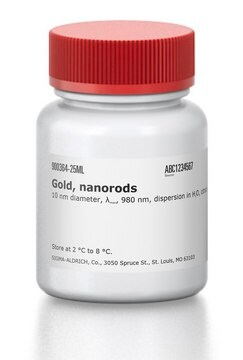771686
Gold nanorods
25 nm diameter, λmax, 650 nm, dispersion in H2O
Sinónimos:
Au nanorods, Gold nanorod
About This Item
Productos recomendados
formulario
colloidal suspension
dispersion in H2O
nanorod
Nivel de calidad
contiene
CTAB as stabilizer
concentración
>45 μg/mL in H2O
diám. × L
25 nm × 60 nm (±10%)
diámetro
25 nm
λmáx.
650 nm
Mw/Mn
>95 (rods)
temp. de almacenamiento
2-8°C
InChI
1S/Au
Clave InChI
PCHJSUWPFVWCPO-UHFFFAOYSA-N
¿Está buscando productos similares? Visita Guía de comparación de productos
Descripción general
Aplicación
Características y beneficios
Información legal
Código de clase de almacenamiento
10 - Combustible liquids
Clase de riesgo para el agua (WGK)
WGK 2
Punto de inflamabilidad (°F)
Not applicable
Punto de inflamabilidad (°C)
Not applicable
Elija entre una de las versiones más recientes:
¿Ya tiene este producto?
Encuentre la documentación para los productos que ha comprado recientemente en la Biblioteca de documentos.
Los clientes también vieron
Artículos
Gold nanostructures such as nanorods, nanowires and microgold have found applications in exciting fields such as biomedical engineering, catalysis and diagnostics.
Silver nanomaterials have unique physical, chemical, and optical properties that are currently being leveraged for a wide variety of biological applications.
In many technologies, performance requirements drive device dimensions below the scale of electron mean free paths (λe). This trend has increased scientific interest and technological importance of electrical resistivities at the nanoscale.
Inorganic nanomaterials are tunable by size, shape, structure, and/or composition. Advances in the synthesis of well-defined nanomaterials have enabled control over their unique optical, electronic, and chemical properties stimulating tremendous interest across a wide range of disciplines. This article illuminates some of the recent research advances of inorganic nanoparticles (NPs) in optoelectronics applications.
Nuestro equipo de científicos tiene experiencia en todas las áreas de investigación: Ciencias de la vida, Ciencia de los materiales, Síntesis química, Cromatografía, Analítica y muchas otras.
Póngase en contacto con el Servicio técnico![Dichlorodi-μ-chlorobis[(1,2,3,6,7,8-η-2,7-dimethyl-2,6-octadiene-1,8-diyl]diruthenium(IV) 97%](/deepweb/assets/sigmaaldrich/product/structures/183/511/879fb3f2-220a-45c9-bb2b-3799730a6693/640/879fb3f2-220a-45c9-bb2b-3799730a6693.png)



![RuCl(p-cymene)[(S,S)-Ts-DPEN]](/deepweb/assets/sigmaaldrich/product/structures/596/849/f8e3d2d8-a02e-430e-b0ed-c208cea3a6fb/640/f8e3d2d8-a02e-430e-b0ed-c208cea3a6fb.png)


